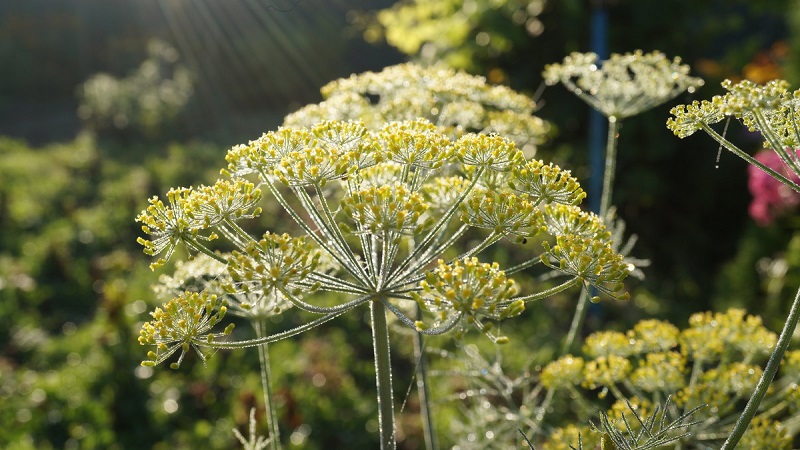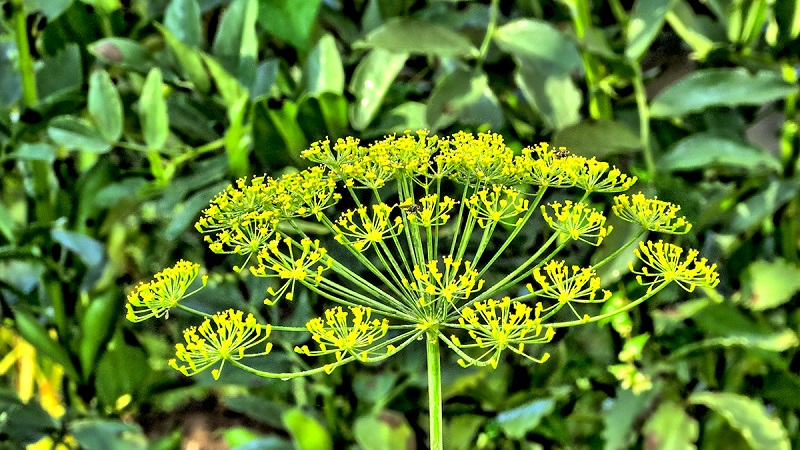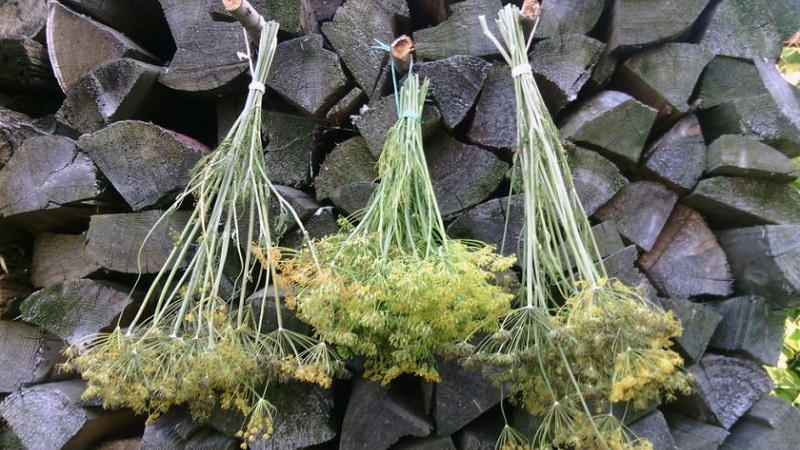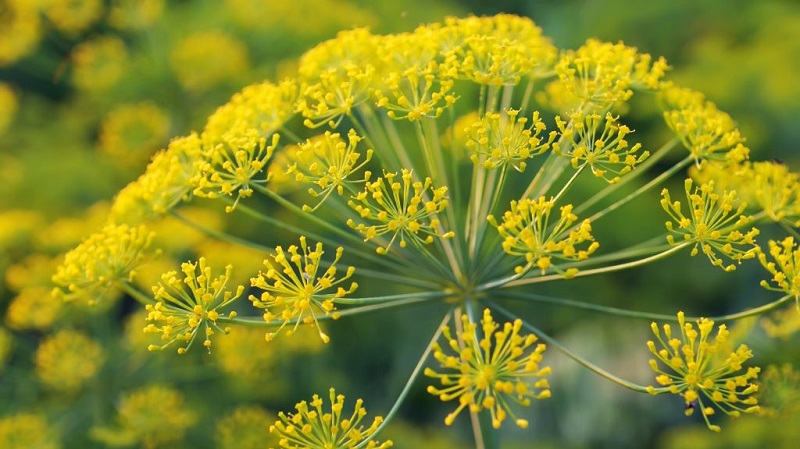Fields of application of dill umbrellas: for treatment, beauty and preparation of delicious dishes
Dill umbrellas are used as an aromatic seasoning for hot and cold dishes, salted, dried, used in various mixtures of spices, for conservation. The inflorescences are used in folk medicine as a wound healing, diuretic, sedative, antispasmodic, carminative. Dill umbrellas are used even in cosmetology.
Consider the composition and medicinal properties of dill inflorescences, the peculiarities of their use in different industries, the benefits for weight loss. Let's find out how to properly assemble and store umbrellas for the winter.
The content of the article
What are dill umbrellas
Dill is an annual herb. It is cultivated everywhere on all continents. It has a single branched stem, pinnately dissected leaves of a deep green color, inflorescences consisting of small bisexual flowers and collected in small umbrellas.
Dill fruits are ovoid seeds with a ribbed surface 2-5 mm long, 1.5-4 mm thick, dark gray or brown in color. In the photo - dill umbrellas in the flowering phase.
For reference. Other names for dill are til, kama, tsap, summit, koper, shivit.
Composition and useful properties
Dill inflorescences are a source of protein, beta-carotene, ascorbic and nicotinic acids, choline, vitamins of group B, D, E, H, K, PP.
The umbrellas contain useful substances for the human body:
- alimentary fiber;
- organic acids;
- ash;
- starch;
- mono - and disaccharides;
- omega-3 and omega-6 fatty acids;
- saturated fatty acids;
- macroelements: silicon, magnesium, sodium, sulfur, phosphorus, chlorine, calcium, potassium;
- trace elements: boron, molybdenum, vanadium, selenium, iron, zinc, manganese, fluorine, iodine, chromium, copper, aluminum, cobalt, lithium, nickel, rubidium, strontium.
The usefulness of inflorescences is in a varied chemical composition. With frequent use, umbrellas improve digestion, enhance the secretion of the digestive glands, activate intestinal peristalsis, normalize metabolism in the body, and increase appetite.
Due to the presence in the composition of plant fiber in a large volume, umbrellas are used in dietary nutrition. Fiber well cleanses the intestines from toxins and toxins, removes excess fluid, promotes fast and long-term saturation, accelerates the process of breaking down fats, due to which weight loss occurs.
Dill has a positive effect on the heart and blood vessels: restores blood circulation, lowers cholesterol, improves the elasticity of the vascular walls, and ensures the normal functioning of the myocardium. Inflorescences serve as an effective prevention of ischemia, atherosclerosis, heart failure.
Due to its diuretic abilities, dill greens are used for liver and kidney diseases: it increases the rate of urine formation and reduces the fluid content in tissues and serous cavities, relieves edema.
Vitamin A is responsible for normal development, skin and eye health, and reproductive function. Potassium and magnesium improve transmission from nerve cells to muscles of excitement, stabilize blood pressure, maintain water and electrolyte balance, take part in protein and carbohydrate metabolism.
Beta-carotene slows down the aging process in the body, inhibits the growth of cancer cells, and has antioxidant properties. Vitamin C strengthens the immune system.It is necessary for the growth and formation of new cells, teeth, bone tissue, and prevents infection from entering the body.

The use of dill umbrellas
Dill inflorescences are used in cosmetology, cooking, as a medicinal raw material in traditional medicine. They use the fruits separately, process the seeds for oil, prepare an infusion, a decoction based on dill umbrellas.
In dietary nutrition
Nutritionists slimming recommend using dill oil, herbs, decoction from plant seeds. All parts of dill contain practically no fat, but are rich in proteins and carbohydrates, which the body needs for saturation.
Umbrella seeds contain a lot of plant fiber, which accelerates lipid metabolism, cleanses the intestines from toxins and toxins, removes excess fluid, improves digestion, regulates metabolic processes, and ensures fast and long-term saturation.
In addition, frequent use dill seed As an aromatic condiment, it improves mood, which in turn eliminates the need for snacks and "seizing" problems, and therefore prevents overeating.
In folk medicine
Dill umbrellas are used to treat and prevent a wide range of diseases. With regular and correct use, they have a beneficial versatile effect on the body:
- Improves digestion. Essential oils in the composition of inflorescences enhance the production of digestive juice, activate the secretion of bile, and stimulate intestinal peristalsis.
- Normalize weight. They remove toxins and toxic substances from the intestines, restore a slow metabolism, lower cholesterol levels, and dull hunger.
- Relieve insomnia. They improve night sleep, calm the nervous system, increase the synthesis of hormones of hypnotic manipulation of consciousness.
- Supports bone health. They participate in the mineralization of teeth, in the processes of transmission of nerve impulses and blood coagulation, increase the density of bone tissue, and reduce the excretion of calcium by the kidneys.
- Facilitate the course of diabetes. They regulate the production of insulin, reduce the level of glucose in the blood, prevent complications, the progression of the disease.
- Eliminate constipation. They normalize the consistency of feces, facilitate the process of defecation, and neutralize increased gas formation.
- Form antimicrobial immunity, increase the body's resistance to the effects of adverse external and internal factors, serve as a good prevention of influenza, acute respiratory viral infections, acute respiratory infections.
- Help with colic in babies. Relieve painful stomach cramps, improve bowel function, reduce flatulence.
- Freshen the breath improve the condition of mucous membranes, help prevent or stop the growth of microbial infections in the mouth, prevent damage to teeth and gums by free radicals.
- Minimize the risk of developing cancer cells, protect the body from the harmful effects of free radicals.
- Purify blood, kidneys, liver.
- Improves skin condition, activates hair growth.
- Responsible for night vision maintain visual acuity.
- Reduce soreness inhibit the activity of inflammation in rheumatic diseases.
- Reduce the tone of skeletal muscles, eliminate muscle stiffness, ease the course or prevent the onset of spasm.
Inflorescence of inflorescences is recommended for women during breastfeeding to improve lactation, with menstrual irregularities. A decoction of dill umbrellas has a vasodilating effect, therefore it is useful for people suffering from hypertension, ischemic disease, angina pectoris, coronary insufficiency.
As an expectorant, it is used for diseases of the upper respiratory tract without sputum discharge.

In cosmetology
Extracts from greens and dill seeds are also used in cosmetology. They are used for the preparation of perfume and cosmetic compositions.The essential oil of inflorescence fruits is injected into toothpaste, cologne, creams. Dill umbrella lotions on the eyes are recommended to relieve redness and inflammation.
At home, use a tincture made from dill inflorescences. Umbrellas in the amount of 2-3 pcs. pour 500 ml of vodka and leave in a dark place for three days to infuse.
With proper and regular use, the product dries acne, cleanses and tightens pores, destroys bacteria that cause inflammation, thereby preventing new breakouts.
In cooking
In the culinary industry, inflorescences are used in dry, fresh, salted form for cooking as a seasoning, as an ingredient in various spice mixtures. The aromatic seasoning is added to hot and cold dishes. The seeds are popular as a flavoring agent for confectionery, pickles, pickles, tea, and sauerkraut.
Oil is made from the seeds of flowering greenery, which is used in the food industry as a spice.
For reference. Greens lose their taste and aroma during heat treatment, so they are added to dishes at the end of cooking.

For winter preparations
Dried or fresh dill umbrellas are used for conservation during the flowering period. The plant contains phytoncides, which, when salted vegetables, not only give a specific spicy taste, but also prevent the formation of mold and prevent damage.
How to properly collect umbrellas
As a medicinal raw material or food product, it is better to use dill umbrellas grown independently, without the use of pesticides. When buying dill, pay attention to the condition of the stems and leaves. In a good plant, they should be fresh, bright green, airy, without signs of wilting.
The seeds are harvested when they begin to ripen, in July-September. The inflorescences are carefully cut, form a bunch of several branches, placed in a paper bag with the inflorescences down and left in a warm, well-ventilated room for 7-10 days. Then the seeds are easily separated and stored in a dry sealed glass container.
In a special dryer for fruits and vegetables, the process of drying umbrellas takes less than a day. You can dry the umbrellas in a ventilated dark place by spreading the inflorescences on a clean material.
For reference. In the oven, dill is dried at a minimum temperature. Drying time depends on the humidity of the umbrellas, on average 15-30 minutes.

How and where to store them
Fresh umbrellas are stored in the refrigerator in an opened plastic bag or wrapped in a damp paper towel. Inflorescences and leaves quickly wither and turn yellow, so you need to use them within 5-7 days.
For long-term storage, the fruits of the inflorescences are dried, freeze, canning. Dried seeds are stored in a dry sealed container, out of direct sunlight. The shelf life is 36 months.
When dry freezing, umbrellas are packaged in special freezer bags or dry clean plastic containers. Store in the freezer until the next harvest.
Contraindications
Dill is a safe food product that is well accepted by the body and has practically no contraindications. Do not use dill umbrellas as a medicine or aromatic seasoning for people with individual intolerance to the components of the composition.
An allergic reaction is manifested by a rash, peeling on the skin, redness, itching, Quincke's edema.
Dill is used with caution under reduced pressure, in late pregnancy, so as not to provoke premature birth, before the planned operation.

Conclusion
Dill inflorescences, fruits, greens are used in the cosmetic, canning industry, used in various mixtures of spices.Infusions and decoctions based on dill umbrellas have found application in the treatment and prevention of diseases of the heart, blood vessels, respiratory organs, nervous and digestive systems.
The obvious advantage of dill is availability and low cost, long shelf life, which allows it to be used at any time of the year. However, in order to avoid possible adverse reactions, you must first consult with your doctor.